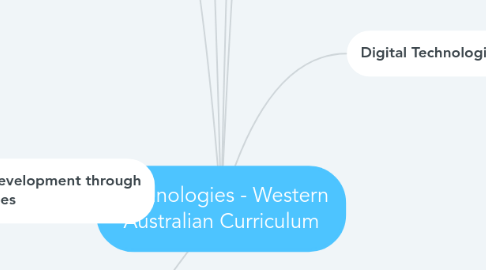
1. Design and Technologies
1.1. Design thinking and technologies
1.2. “Design thinking is a process for creative problem solving.” (Stafford, 2018)
1.2.1. WHY IS DESIGN THINKING IMPORTANT FOR STUDENTS?
1.2.2. Increasing faster learning for students
1.2.3. Produces design solutions that are innovative
1.3. Production of solutions
1.4. Providing opportunities and needs for all students
1.5. KNOWLEDGE & UNDERSTANDING - How does technology impact our lives? - the way we think, the way we will think in the future, how will our society change through the use and development of technology
1.6. PROCESSES & PRODUCTION SKILLS - designing solutions through various technologies - investigating, defining, generating, designing, producing, implementing, evaluating, collaborating = THE SKILLS STUDENTS DEVELOP THROUGH DESIGN THINKING AND DEVELOPMENT
1.7. Huge ETHICAL emphasis - how can students create, design and implement new technologies whilst keeping our environment and the work sustainable
2. Technologies
2.1. Students need to develop skills to analyse and creatively respond to problems, challenges and situations.
2.2. CREATE SOLUTIONS - AIM!!!
3. Student Development through technologies
3.1. Dexterity - developing skills, especially whilst using the hands
3.2. Motivation and willingness to learn
3.3. Engaged, focused learners
3.4. Curiosity, confidence, persistence, innovation, creativity, respect, cooperation
3.5. Develops communication and collaboration
3.6. Connects students to a global society, encourages a positive digital citizenship
4. SUSTAINABILITY
4.1. Students develop new ways of thinking to help keep our environment sustainable
4.2. Through technologies and design thinking, students are able to innovate and create new ways of using technology and new eco-friendly technologies
5. Digital Technologies
5.1. Computational thinking
5.1.1. A problem-solving method that involves various techniques and strategies that can be implemented by digital systems. Techniques and strategies may include organising data logically, breaking down problems into parts, defining abstract concepts and designing and using algorithms, patterns and models. (ACARA, 2018)
5.1.1.1. FOUR PARTS to COMPUTATIONAL THINKING
5.1.1.2. 1. Decomposition - the separation of a complex problem into parts to allow a problem to be easily understood. (ACARA, 2018)
5.1.1.3. 2. Pattern Matching - A mechanism for checking a value against a pattern. (Scala, n.d.)
5.1.1.4. 3. Abstraction - The process of reducing complexity to formulate generalised fundamental ideas or concepts removed from the specific details or situation. (ACARA, 2018)
5.1.1.5. 4. Algorithms - A description of the steps and decisions required to solve a problem. (ACARA, 2018)

